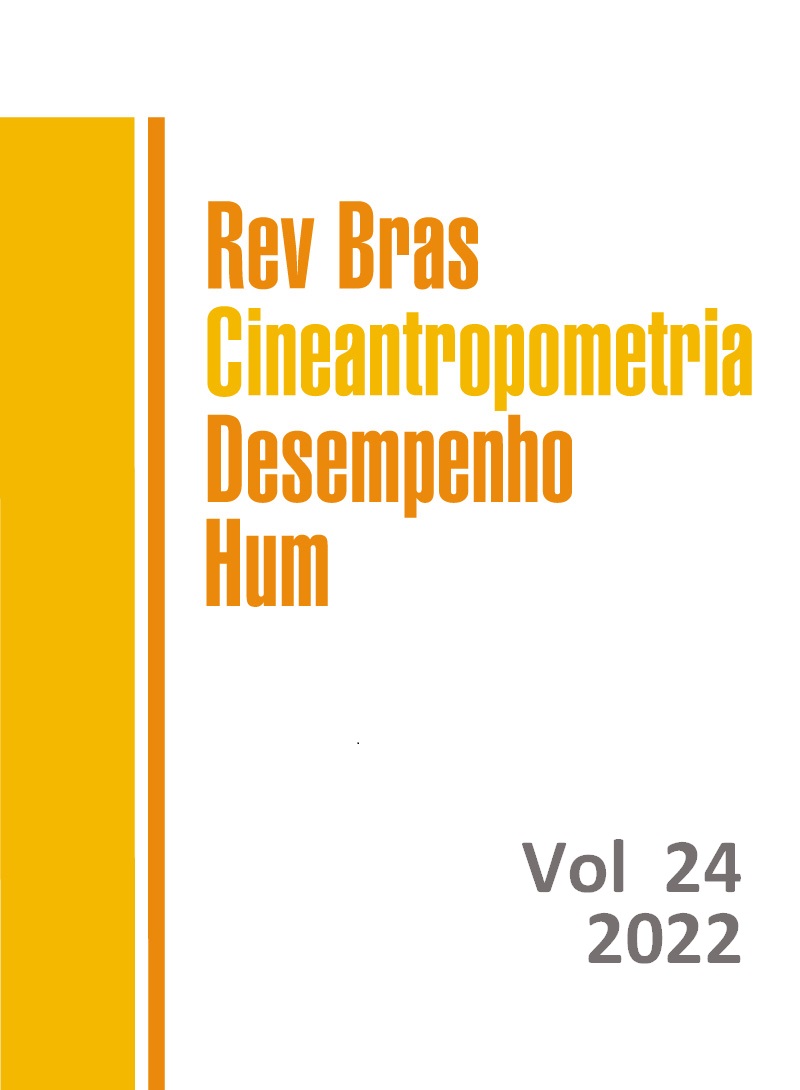Characterizing the magnitude of vibration imposed by stochastic whole-body vibration platforms used in rehabilitation and training: a preliminary study
DOI:
https://doi.org/10.1590/1980-0037.2022v24e77572Keywords:
Acceleration, Rehabilitation, Stochastic Processes, TrainingAbstract
The use of devices that produce stochastic whole-body vibration as a resource for rehabilitation and training programs has been founded on the theory of stochastic resonance. However, the prescription of rehabilitation and training programs must be preceded by the verification of imposed-vibration magnitude and of how it can be affected by the presence of an individual on the devices. The aim of this research was to characterize and analyze the effect of an individual's mass on the vibratory stimulus provided by stochastic whole-body vibration (SWBV) devices. The sample consisted of 30 repetitions for each one of the 6 vibration levels of the SWBV device (level 02, 04, 06, 08, 10 and 12), performed in two experimental situations (Without Load; Load [70Kg]; ? 35 kg on the right and left surfaces of the platform). For the antero-posterior, latero-lateral, and vertical directions, all variables showed significant differences between treatments, levels and interaction between experimental factors (p<.05), except for the Disp variable between treatments (p=.075). To measure vibration magnitude, a triaxial accelerometer was attached at the center of the board of one of the platform surfaces. Load interferes with parameters of vibration imposed by SWBV platforms, increasing ARMS and APEAK in the latero-lateral and antero-posterior directions, reducing these same parameters in the vertical direction.
References
Chanou K., Gerodimos V, Karatrantou K, Jamurtas A. Whole-body vibration and rehabilitation of chronic diseases: A review of the literature. J Sci Med Sport 2012; 11(2): 187–200.
Rittweger J. Vibration as an exercise modality: How it may work, and what its potential might be. Eur J Appl Physiol 2010; 108(5): 877–904.
Spiliopoulou SI, Amiridis IG, Tsigganos G, Hatzitaki V. Side-alternating vibration training for balance and ankle muscle strength in untrained women. J Athl Train 2013; 48(5): 590–600.
Vasconcellos RP, Schultz GR, Santos SG. The interference of body position with vibration transmission during training on a vibrating platform. Rev Bras Cineantropom Desempenho Hum 2014, 16(6):597-607
Lamas L, Tricoli V, Batista M, Ugrinowitsch C. Acute effect of whole-body vibration on high velocity squat and jump performance. Rev Bras Cineantropom Desempenho Hum 2010, 12(6):401-407.
Cordo P, Inglis J, Verschueren S, Collins J, Merfeld D. Noise in Human muscle spindles. Nature 1996, 383: 769–770.
Haas C, Turbanski S, Schimidtbleicher D. Postural control training in Parkinson’s disease. Isokinet Exerc Sci 2004; 12: 11–40.
Turbanski S, Haas CT, Schmidtbleicher D, Friedrich A, Duisberg P. Effects of random whole-body vibration on postural control in Parkinson’s disease. Res Sports Med 2005, 13(3): 243–256.
Fallon JB, Carr RW, Morgan DL. Stochastic resonance in muscle receptors. J Neurophysiol 2004, 91(6): 2429–2436.
Martínez L, Pérez T, Mirasso CR, Manjarrez E. Stochastic resonance in the motor system: Effects of noise on the monosynaptic reflex pathway of the cat spinal cord. J Neurophysiol 2007, 97(6): 4007–4016.
Elfering A, Arnold S, Schade V, Burger C, Radlinger L. Stochastic resonance whole-body vibration, musculoskeletal symptoms, and body balance: A worksite training study. Saf Health Work 2013, 4(3): 149–155.
Kaut O, Becker B, Schneider C, Zhou F, Fliessbach K, Hurlemann R, Wüllner U. Stochastic resonance therapy induces increased movementrelated caudate nucleus activity. J Rehabil Med 2016, 48(9): 815–818.
Haas CT, Buhlmann A, Turbanski S, Schmidtbleicher D. Proprioceptive and sensorimotor performance in Parkinson’s disease. Res Sports Med 2006, 14(4): 273–287.
Griffin MJ. Handbook of Human Vibration. Burlington: Academic Press; 1996.
Abercromby AFJ, Amonette WE, Layne CS, McFarlin BK, Hinman MR, Paloski W H. Vibration exposure and biodynamic responses during whole-body vibration training. Med Sci Sports Exerc 2007, 39(10): 1794–1800.
Pel JJM, Bagheri J, Van Dam LM, Van Den Berg-Emons HJG, Horemans HLD, Stam HJ, Van Der Steen J. Platform accelerations of three different whole-body vibration devices and the transmission of vertical vibrations to the lower limbs. Med Eng Phys 2009, 31(8): 937–944.
Rauch F, Sievanen H, Boonen S, Cardinale M, Degens H, Felsenberg D, et al. Reporting whole-body vibration intervention studies: Recommendations of the International Society of Musculoskeletal and Neuronal Interactions. J Musculoskelet Neuronal Interact 2010, 10(3): 193–198.
Blasimann A, Fleuti U, Rufener M, Elfering A, Radlinger L. (2014). Electromyographic activity of back muscles during stochastic whole body vibration. J Musculoskelet Neuronal Interact, 14(3): 311–317.
Donocik K, Hartman-Petrycka M, Lebiedowska A, Błońska-Fajfrowska B. Alterations in the ability to maintain balance as a result of stochastic resonance whole body vibration in women. Plos One 2017, 12(9): 1–19.
Faes Y, Maguire C, Notari M, Elfering A. Stochastic Resonance Training Improves Balance and Musculoskeletal Well-Being in Office Workers: A Controlled Preventive Intervention Study. Rehabil Res Pract 2018, 1–9.
Herren, K., Schmid, S., Rogan, S., & Radlinger, L. (2018). Effects of Stochastic Resonance Whole-Body Vibration in Individuals with Unilateral Brain Lesion: A Single-Blind Randomized Controlled Trial: Whole-Body Vibration and Neuromuscular Function. Rehabil Res Pract 2018, 1–11.
Knudson D. The Fundamentals of Biomechanics. Chico: Springer; 2007.



